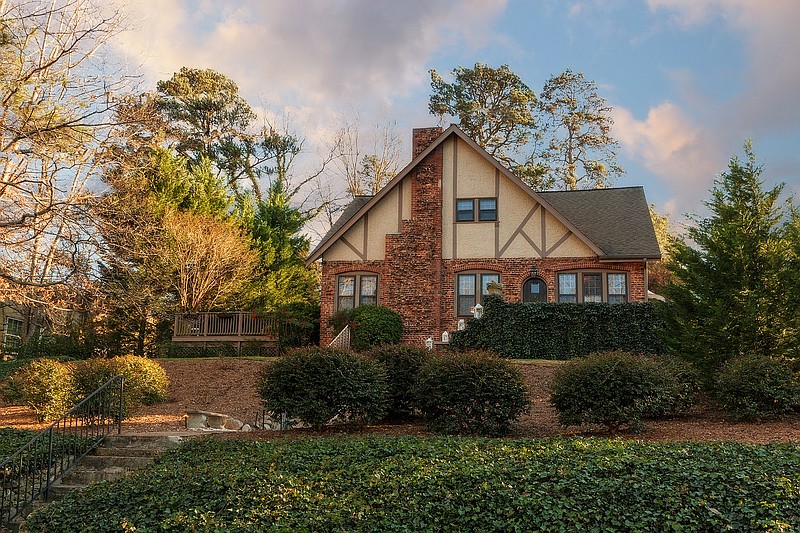When life is filled with scrolling media updates and a new trends lurk behind every calendar page, it's refreshing to find something made to last. Starr and Nate Card's Tudor home stands as serene and alluring on its North Chattanooga hillside as it must have after its construction in 1920, offering a 21st century family the enduring charms of its generously sized rooms and half-timbered façade.
"This house has really great proportions, so it's really fun to play with the small and large rooms," says Rob Praino, of Robin Praino Interiors, the couple's interior decorator and friend. All three bedrooms are large enough for a king-sized bed, and the main floor is divided into several living spaces ranging from the intimate sitting room at the main entrance to the more spacious living room adjacent.
Not only does the 3,500-square-foot floor plan transcend the Prohibition period, the architecture of the house does as well, its rounded arch doorways and immense stone fireplace as appreciated in home construction now as they were a century ago. In many rooms, the crown molding, while elaborately carved, is painted the same shade as the walls but with a glossier finish, modernizing the appeal of the highly crafted trim. "The details from that era set a nice background to put unique furniture in," says Praino.
Sharing a close friendship as well as similar taste with Starr Card gives the decorator another leg up. As an invitee at parties, he experiences how guests congregate and flow, which helps him see how the décor should function. "Starr had a very defined style. She knows what she likes, and it's been an easy process," Praino says.
Since they work well together, Praino and Starr Card take their time on shopping trips to source unique pieces, and she often trusts him to choose decor sight unseen. Their close collaboration has resulted in a style consistent throughout the home that Praino coins "new Southern." Antique and reproduction pieces blend well with edgy modern elements that share a similar finish or color tone. "I want my personality to show through," she says. "I want it to be beautiful, but I want it to be comfortable, too."
Although most of her furnishings are handpicked, Card leaves room for happenstance. Objects that more or less landed in her lap are well placed, sometimes defining a room. When she inherited a grand piano from her uncle, she let it become the focal point of the entryway sitting room. In the wide front hall that sold her on the house, her great-grandmother's early 20th century, mirror-front cabinet is given priority under a painted portrait of her three children. At the far end of the hall is a painting by local artist and friend Jake Kelley, a piece picked out on a bit of a whim.
Likewise, she and her husband purchased a few items from the home's previous owners, like a pair of gold and silver reproduction sconces in the piano room and the round table that was already at home in the square dining room. Luxurious cream drapes, another holdover in several living spaces, frame the wood side door in the piano room, while twin gilt framed mirrors seem to float on either side, punching up the look.
"The previous owners left us a nice place to start," says Card. Indeed, she and her husband have done no major remodeling on the home in their two years there, although a daunting kitchen transformation is planned to open up the galley room on the back of the house into the adjoining sunlit office space with a massive island.
The master bath on the main floor hall was already done, and done well. Draped nearly all in white like the master bedroom itself, the spacious modern bath takes cues from the period architecture with hexagonal tile flooring and a freestanding tub.
Little did the previous owners know that using all white would suit Starr Card so well. Besides having a decorator on call, the elegance of her interior also stems from the nearly exclusive use of neutral tones. "I have a problem with color," she says confessionally.
Most everything in the house is white, gray, gold or cream, drawing attention to suggestions of color here and there, like a trio of apricot woven storage cubes in the living room, and the steely blue reupholstered bench seat (another score from the previous owners) in the piano room. Above the seat are sets of framed geodes from an Atlanta artist, which, though tiny, contain powerful bursts of pink, blue and other bright hues.
A uniquely worn patina has developed on the piano bench across the room. For a time, Card considered refinishing it, but she says that every mark on the bench as well as the house, hints at its long history, one that she wishes she knew more of.
But sometimes even things built to last need a fresh coat of paint now and then. The next project the Cards hope to tackle is a sprucing up of the exterior, although it looks homey now with landscaping from the experts at Phillips|Creasey.
From the piano room, double doors lead out to one of two great outdoor living spaces: an intimate side porch, part of the tiled patio that wraps the front right corner of the house. On the other side of the house is a generous deck with an elevated stage often used for parties. One large space, one small - variety that echoes the interior of the wonderful house.
The original builder must have understood that sometimes families need large areas for congregating, and other times, one needs a cozy place all to oneself. "I feel like it will always be a work in progress," says Card, "but the bones of the house are so good, and that's what's really important."
